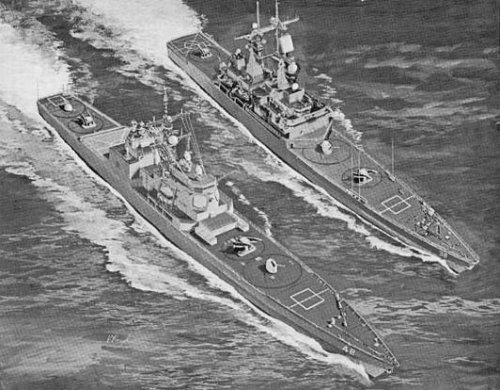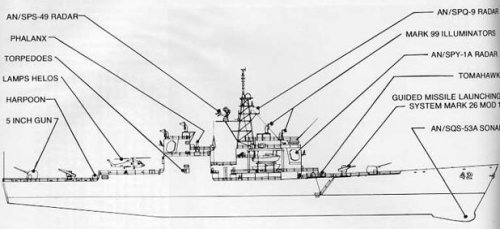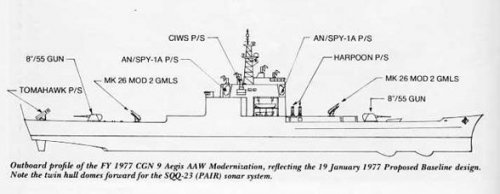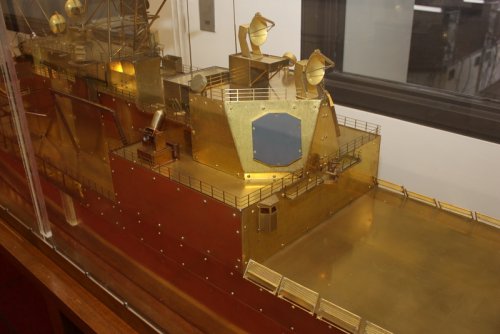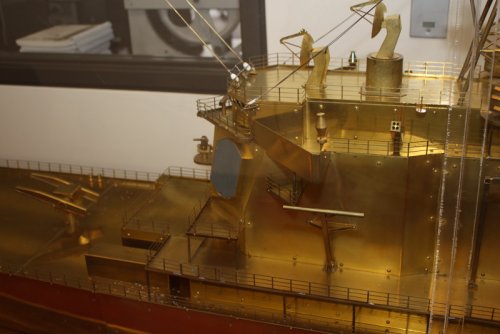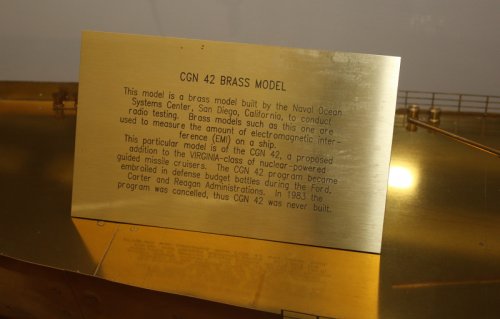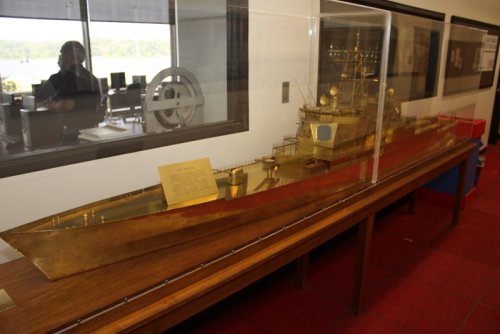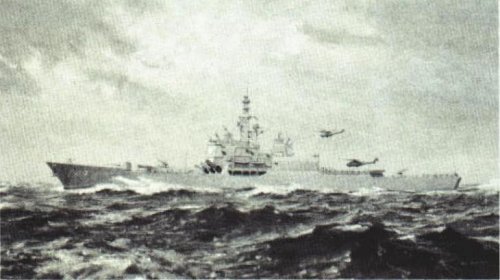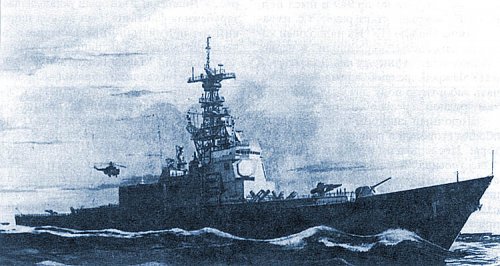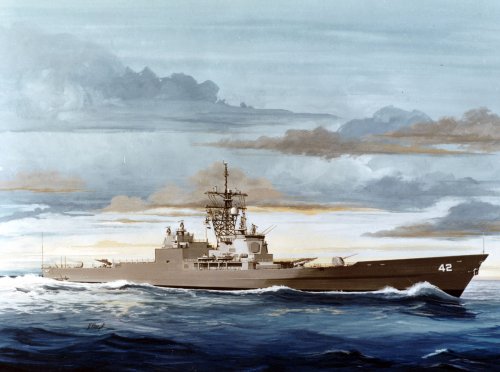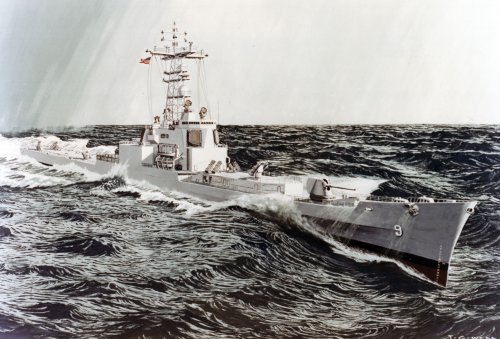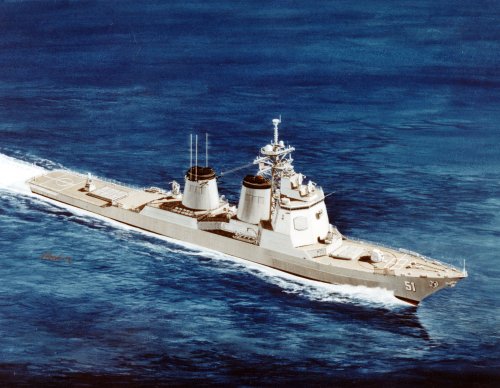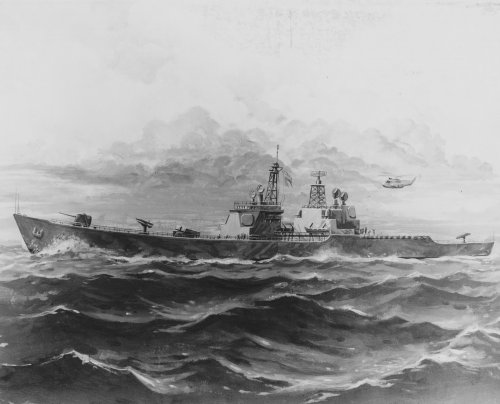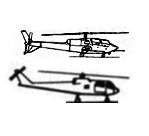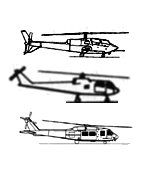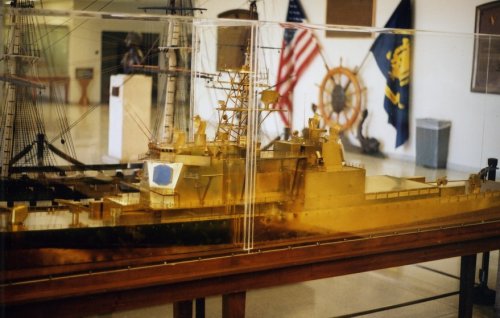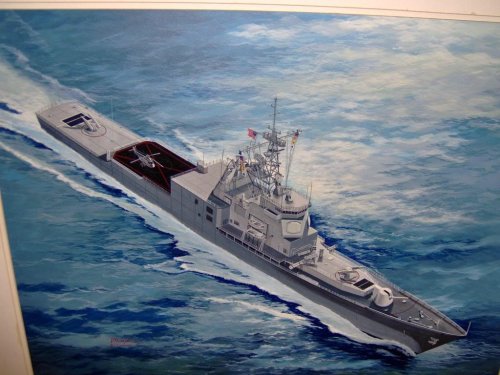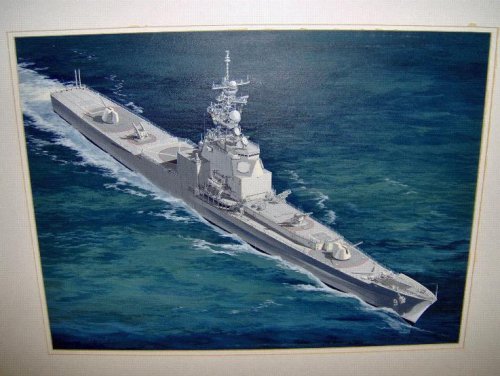You are using an out of date browser. It may not display this or other websites correctly.
You should upgrade or use an alternative browser.
You should upgrade or use an alternative browser.
Strike Cruiser from the 80s
If I recall correctly the image of the CSGN Mk2 featured in McLaughlins book on Hybrids does feature an aft mounted VLS but retained the Mk26 fwd, if I again recall correctly because at that stage the Mk26 was required to fire ASROC as VL Asroc was not in the offing.
It interesting to compare the CSGN Mk2 with Invincible which are slightly analogous in terms of armament layout; I have seen a line drawing of Vini with a second Sea Dart Launcher aft of the island,
and the blast screen felt necessary by the Royal Navy. To para phrase Lt Col Kilgore in Apocolypse Now - I love the smell of toasted sailors in the morning.
It interesting to compare the CSGN Mk2 with Invincible which are slightly analogous in terms of armament layout; I have seen a line drawing of Vini with a second Sea Dart Launcher aft of the island,
and the blast screen felt necessary by the Royal Navy. To para phrase Lt Col Kilgore in Apocolypse Now - I love the smell of toasted sailors in the morning.
- Joined
- 16 April 2008
- Messages
- 9,605
- Reaction score
- 14,494
JohnR, you're quite right about the pic in Hybrid Warships. I'm not sure that ASROC was the reaosn for the mixed MK26/MK41 configuration, but it's as plausible as anything else I've seen.
The comparison with Invincible is a bit deceptive, though, since the CSGN's air complement was much smaller and all housed at the weather deck level, with no deck park planned. That made the blast shields seen on Invincible less necessary because flight deck crews would not be out in the open except for fairly short windows for launch and recovery.
The comparison with Invincible is a bit deceptive, though, since the CSGN's air complement was much smaller and all housed at the weather deck level, with no deck park planned. That made the blast shields seen on Invincible less necessary because flight deck crews would not be out in the open except for fairly short windows for launch and recovery.
Jemiba said:Just found, where I wouldn't have searched for it, in the "Enzyklopädie
der Raketen & Lenkwaffen" (Encyclopedia of rockets and missiles): A
side view of the DDG 47
The illustration is incorrectly labeled. It is the outboard profile of the Aegis-modified Virginia-class (CGN 42) not DDG 47 that became the Ticonderoga-class (CG 47).
HeavyG
ACCESS: Confidential
- Joined
- 21 August 2009
- Messages
- 80
- Reaction score
- 18
The Ticonderoga class was mostly derived from the Spruance class with the biggest change being the massive superstructure to accomodate the SPY-1 radar system. The Virginia class was probably the closest class to resembling the strike cruiser. I had read somewhere that in fact the strike cruiser was going to be a modiified Virginia class with changes to the superstructure to accomodate the Aegis sensor system.
HeavyG said:The Ticonderoga class was mostly derived from the Spruance class with the biggest change being the massive superstructure to accomodate the SPY-1 radar system. The Virginia class was probably the closest class to resembling the strike cruiser. I had read somewhere that in fact the strike cruiser was going to be a modiified Virginia class with changes to the superstructure to accomodate the Aegis sensor system.
According to Norman Friedman, the Aegis-modified Virginia-class was a more modest ship proposed by the Carter Administration after the new nuclear-powered strike cruiser designs and the Aegis-modified Long Beach-class, and new Aegis-equipped Long Beach-class ships, were deemed to be too expensive. The Aegis-modified Virginia-class, or CGN 42, was never designated as a strike cruiser, but its design was influenced by the CSGN experience. Four ships were originally planned, one for each nuclear-powered aircraft carrier. Although an extremely powerful warship, she was not as survivable as the CSGN and could not accommodate such flag facilities as the highly automated Tactical Support Center (TSC).
In the Fall of 1978, Secretary of Defense Harold Brown stated that one Aegis-modified Virginia-class nuclear cruiser would cost as much as two DDG 47 class ships, the then designation of the Ticonderoga-class, and provide as much air defense. At the time, the Carter Administration was not interested in building new nuclear-powered aircraft carriers and instead wanted to build the conventionally powered CVV. During the period, it was believed that two CVV aircraft carriers could be built for the cost of one new Nimitz-class aircraft carrier. In the tight defense budget, the CGN 42 class was canceled.
Source: US Destroyers: An Illustrated History by Norman Friedman, Naval Institute Press, 2004.
http://books.google.com/books?id=Tzp58htKLkEC&pg=PA346&lpg=PA346&dq=CGN-42+class&source=bl&ots=PGVHKaE0CK&sig=CG9H58EHiY3dgqatisD-oO-DTn0&hl=en&ei=x3u6Sr7RBIz-sgOrk4iABg&sa=X&oi=book_result&ct=result&resnum=2#v=onepage&q=CGN-42%20class&f=false
Photographs of brass model of CGN-42 on display at Rickover Hall of the United States Naval Academy.
Source:
http://bbs.stardestroyer.net/viewtopic.php?style=4&f=14&t=136289&view=next
Source:
http://bbs.stardestroyer.net/viewtopic.php?style=4&f=14&t=136289&view=next
Attachments
Official U.S. Navy photo of artist's conception of its nuclear-powered strike cruiser (CSGN) circa 1976.
Source: "On the Navy Horizon:", All Hands, July 1976
http://www.navy.mil/media/allhands/acrobat/ah197607.pdf
Source: "On the Navy Horizon:", All Hands, July 1976
http://www.navy.mil/media/allhands/acrobat/ah197607.pdf
Attachments
Triton said:Photographs of brass model of CGN-42 on display at Rickover Hall of the United States Naval Academy.
Hey now! I took those photos. ;D
Okay, since this seems to be the CSGN, CGN, CGN-9, and DDGX thread....
Attachments
Awesome RyanCrierie! Thank you for posting. 
- Joined
- 26 September 2008
- Messages
- 1,960
- Reaction score
- 746
pometablava said:From Aviation & Marine magazine
That one is just rather odd. The helicopter doesn't look like a Seasprite or Seahawk. I suspect that the rest of the drawing is off as well.
- Joined
- 26 September 2008
- Messages
- 1,960
- Reaction score
- 746
RyanCrierie said:Triton said:Photographs of brass model of CGN-42 on display at Rickover Hall of the United States Naval Academy.
Hey now! I took those photos. ;D
Okay, since this seems to be the CSGN, CGN, CGN-9, and DDGX thread....
Those are really nice.
So where did you get that CGN-9 image? Is it possible to get a better quality version? The artist's name is cut off at the bottom, and I'm wondering if the color is off?
I'm a big fan of the Long Beach as well as the Bainbridge. Always loved those ships when I was a kid. Never saw any of the proposed upgrades for the Long Beach.
- Joined
- 29 September 2006
- Messages
- 1,793
- Reaction score
- 1,360
blackstar said:pometablava said:From Aviation & Marine magazine
That one is just rather odd. The helicopter doesn't look like a Seasprite or Seahawk. I suspect that the rest of the drawing is off as well.
It seems to resemble a YAH-63, the Bell copter that lost to the YAH-64.
http://www.secretprojects.co.uk/forum/index.php/topic,532.msg6402.html#msg6402
- Joined
- 26 September 2008
- Messages
- 1,960
- Reaction score
- 746
starviking said:blackstar said:pometablava said:From Aviation & Marine magazine
That one is just rather odd. The helicopter doesn't look like a Seasprite or Seahawk. I suspect that the rest of the drawing is off as well.
It seems to resemble a YAH-63, the Bell copter that lost to the YAH-64.
http://www.secretprojects.co.uk/forum/index.php/topic,532.msg6402.html#msg6402
It does. Not that that makes any sense...
- Joined
- 29 September 2006
- Messages
- 1,793
- Reaction score
- 1,360
blackstar said:starviking said:blackstar said:pometablava said:From Aviation & Marine magazine
That one is just rather odd. The helicopter doesn't look like a Seasprite or Seahawk. I suspect that the rest of the drawing is off as well.
It seems to resemble a YAH-63, the Bell copter that lost to the YAH-64.
http://www.secretprojects.co.uk/forum/index.php/topic,532.msg6402.html#msg6402
It does. Not that that makes any sense...
There was a planned Sea Apache in the 80s, so perhaps the idea was kicking around earlier and the artist added in a YAH-63 to the Strike Cruiser drawing.
- Joined
- 22 January 2006
- Messages
- 4,213
- Reaction score
- 2,010
I posted this drawing to see if anyone could see the YAH-63.  Congratulations to starviking!
Congratulations to starviking!
I was very surprised with that detail but I agree with you too about it makes sense to place a naval combat helo in a strike cruiser.
This drawing is contemporary of YAH-63/64 evaluation and, possibly, naval versions were considered for the YAH-63 too.
I've recently posted a strike cruiser operating the Grumman Nutcracker. The Strike Cruiser was definitively an offensive ship.
http://www.secretprojects.co.uk/forum/index.php/topic,10057.0.html
I was very surprised with that detail but I agree with you too about it makes sense to place a naval combat helo in a strike cruiser.
This drawing is contemporary of YAH-63/64 evaluation and, possibly, naval versions were considered for the YAH-63 too.
I've recently posted a strike cruiser operating the Grumman Nutcracker. The Strike Cruiser was definitively an offensive ship.
http://www.secretprojects.co.uk/forum/index.php/topic,10057.0.html
- Joined
- 22 January 2006
- Messages
- 4,213
- Reaction score
- 2,010
I suspect that the rest of the drawing is off as well.
It's a possibility, of course, but I'm not so sure. It's true that we can find such kind of drawings on respectable magazines like AW&ST but the article in Aviation&Marine International, where I found the drawing, looks authoritative to me. The article also covers some other drawings already posted in this topic.
The article is from October 1976 issue
- Joined
- 26 September 2008
- Messages
- 1,960
- Reaction score
- 746
pometablava said:I suspect that the rest of the drawing is off as well.
It's a possibility, of course, but I'm not so sure. It's true that we can find such kind of drawings on respectable magazines like AW&ST but the article in Aviation&Marine International, where I found the drawing, looks authoritative to me. The article also covers some other drawings already posted in this topic.
The article is from October 1976 issue
Is Aviation & Marine an American magazine? I suspect that the drawing was off because the artist was speculating and did not have first-hand information.
- Joined
- 29 September 2006
- Messages
- 1,793
- Reaction score
- 1,360
pometablava said:I posted this drawing to see if anyone could see the YAH-63.Congratulations to starviking!
Well in all honesty it was a team effort - Blackstar spotted the oddity, I just speculated on the identity...
pometablava said:I was very surprised with that detail but I agree with you too about it makes sense to place a naval combat helo in a strike cruiser.
As with the Sea Apache, I wonder what the stated rationale for the aircraft was - air-to-ship attack, air-to-ground, or even sensor platform?
- Joined
- 22 January 2006
- Messages
- 4,213
- Reaction score
- 2,010
Is Aviation & Marine an American magazine?
'Aviation & Marine International'
[Interconair AG, ISSN ? ]
Monthly aviation and naval magazine. "Atlantic Edition" in English only. International version of the Italian title 'Interconair Aviazione Marina'. 102 large format pages each issue, with b+w and colour photos, line drawings etc. Military biased subjects for feature articles. Published 1973 to 1979, at least.
Ceased Publication
I suspect that the drawing was off because the artist was speculating and did not have first-hand information.
From that point of view, your suspicion seems quite reasonable
The Italian original edition was already published back in 1964
http://www.alireggiane.com/riviste-aeronautiche-f13/interconair-aviazione-e-marina-t273.htm
http://cgi.ebay.it/RIVISTA-INTERCONAIR-AVIAZIONE-MARINA-MILITARE-1981-189-/110540568568
Giorgio Apostolo was one of its contributors
- Joined
- 22 January 2006
- Messages
- 4,213
- Reaction score
- 2,010
As with the Sea Apache, I wonder what the stated rationale for the aircraft was - air-to-ship attack, air-to-ground, or even sensor platform?
My question is the same. The Sea Apache profiles I've seen are armed with Harpoon missiles. The Strike Cruiser seems to be a good candidate to match with it.
- Joined
- 18 March 2008
- Messages
- 3,529
- Reaction score
- 978
I very much doubt this image has anything to do with the AHH and/or Sea Apache program. The Sea Apache (known as Grey Thunder) wasn’t conceived until 1984 and then as a replacement for the USMC’s AH-1S Sea Cobra and for the USN. The USN retained a naval attack helicopter requirement for some time to replace its gunship configured Hueys from VietNam. Unlike ASW helos the roles of this chopper was escort of small ships (amphibious assault craft), SEAL support and general coastal interdiction roles. Because of the carrying capacity of the Apache Harpoon and Penguin was quickly added to the list for ASuW. Later as the Sea Apache was evolved combat air patrol was added which saw considerable streamlining added to the Apache. It’s only with the MH-60R that the USN has regained this littoral attack helicopter capability.
I would be very skeptical of identifying this mystery helo as the Bell AAH entry. For one it’s much bigger than the Bell AAH, has a completely different tail and also what appears to be a large sliding side door. It’s clearly just a notional helicopter drawing.
I would be very skeptical of identifying this mystery helo as the Bell AAH entry. For one it’s much bigger than the Bell AAH, has a completely different tail and also what appears to be a large sliding side door. It’s clearly just a notional helicopter drawing.
Attachments
- Joined
- 29 September 2006
- Messages
- 1,793
- Reaction score
- 1,360
Abraham Gubler said:I would be very skeptical of identifying this mystery helo as the Bell AAH entry. For one it’s much bigger than the Bell AAH, has a completely different tail and also what appears to be a large sliding side door. It’s clearly just a notional helicopter drawing.
Whilst there's the possibility that the artist didn't have a good pic of the Bell AAH entry to look at, you do have a very strong point. I was looking for old views of the YAH-63 and came across a page that also has the Boeing Vertol YUH-61A (UTTAS) - it certainly seems to fit the bill better, and was entered in the Navy's LAMPS III competition.
- Joined
- 18 March 2008
- Messages
- 3,529
- Reaction score
- 978
starviking said:I was looking for old views of the YAH-63 and came across a page that also has the Boeing Vertol YUH-61A (UTTAS) - it certainly seems to fit the bill better, and was entered in the Navy's LAMPS III competition.
I'd say you're probably right. With an allowance for artist's error it is very similar.
Attachments
- Joined
- 22 January 2006
- Messages
- 4,213
- Reaction score
- 2,010
With an allowance for artist's error
from my point of view, this time I should say a generous allowance. Anyway it's ok to me.
Abraham Gubler said:I very much doubt this image has anything to do with the AHH and/or Sea Apache program. The Sea Apache (known as Grey Thunder) wasn’t conceived until 1984 and then as a replacement for the USMC’s AH-1S Sea Cobra and for the USN. The USN retained a naval attack helicopter requirement for some time to replace its gunship configured Hueys from VietNam. Unlike ASW helos the roles of this chopper was escort of small ships (amphibious assault craft), SEAL support and general coastal interdiction roles. Because of the carrying capacity of the Apache Harpoon and Penguin was quickly added to the list for ASuW. Later as the Sea Apache was evolved combat air patrol was added which saw considerable streamlining added to the Apache. It’s only with the MH-60R that the USN has regained this littoral attack helicopter capability.
I would be very skeptical of identifying this mystery helo as the Bell AAH entry. For one it’s much bigger than the Bell AAH, has a completely different tail and also what appears to be a large sliding side door. It’s clearly just a notional helicopter drawing.
Thank you, Abraham, for the information.
Naval Surface Combatants in the 1990s: Prospects and Possibilities, Congressional Budget Office, April 1981.
http://www.cbo.gov/ftpdocs/51xx/doc5175/doc15-Part2.pdf
http://www.cbo.gov/doc.cfm?index=5175&type=0
http://www.cbo.gov/ftpdocs/51xx/doc5175/doc15-Part2.pdf
http://www.cbo.gov/doc.cfm?index=5175&type=0
Summary
The decade of the 1970s brought new challenges and uncertainties to the U.S. Navy. Accustomed since World War II to unequivocal dominance at sea, the Navy struggled in the 1970s with the pressures brought about by rapidly advancing technology, the block obsolescence of large numbers of World War II ships, and a vigorous challenge at sea from a Soviet navy growing in strength and confidence.
This struggle has continued into the 1980s. It is nowhere more evident than in that category of warships known as surface combatants--cruisers, destroyers, and frigates. Surface combatants are used in a variety of naval missions, including escorting aircraft carriers as part of a carrier battle group. During a major war, carrier battle groups are intended to be the Navy's primary instrument for gaining control of the seas and for attacking the enemy base structure and forces from the sea. Frontal assaults against Soviet homeland bases would almost certainly encounter stiff resistance from Soviet naval and air forces. Battle groups might also be required to confront additional, although probably less formidable, threats distributed widely over the world's oceans.
Additional tasks undertaken by surface combatants include their employment in surface action groups and as escorts for amphibious forces, underway replenishment groups, and convoys. Surface action groups are naval strike groups that do not contain an aircraft carrier. They are used today in the Middle East and the Carribbean, and could provide forces responsive to other crises in the Third World. Amphibious forces invade land areas from the sea. Underway replenishment groups replenish fuel, ammunition, and stores for warships at sea and are essential for sustained naval operations away from home waters. Merchant ship convoys will almost certainly require vigorous protection against enemy interdiction, as they have in past wars. All of these functions will require surface combatants beyond those needed for carrier battle groups.
Looking ahead to the late 1980s and early 1990s, the Navy faces a substantial drop in the surface combatant force level as the ships delivered in the late 1950s and early 1960s reach retirement age. At the same time, the challenge posed by the forces of potential adversaries has continued to grow.
In addressing this challenge, several related questions must be considered:
* How large a surface combatant force will the Navy have in the 1990s, given the number of new ships already authorized and the ships now in the fleet that will not yet have reached the end of their service lives?
* How might recent technological developments affect the likely role of future surface combatants?
* Given these technological developments, and alternative views of naval strategy, what mix of surface combatants might be considered within whatever budget level the Congress selects?
These questions are the focus of this paper.
marcd30319
ACCESS: Restricted
- Joined
- 9 August 2008
- Messages
- 9
- Reaction score
- 4
The second image appears to be the strike cruiser conversion for the USS Long Beach (CGN-9) which would have received two 8-inch/55 caliber Mark 71 gun mounts, fore and aft, as well as two Mark-26 twin missile launchers, also fore and aft.
- Joined
- 22 January 2006
- Messages
- 4,213
- Reaction score
- 2,010
The second image appears to be the strike cruiser conversion for the USS Long Beach (CGN-9)
You're right, it's the CGN-9 conversion
Similar threads
-
-
-
-
USN Aviation Cruiser Concepts (CGV & MEU Studies)
- Started by Brickmuppet
- Replies: 123
-

